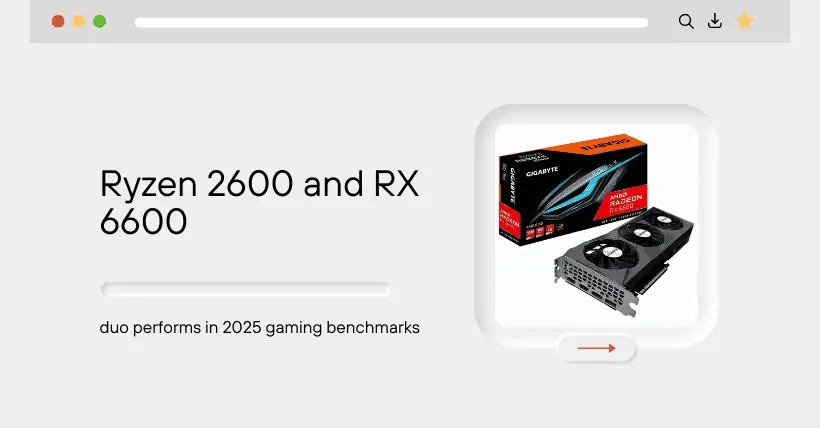01
Introduction
The Ryzen 5 2600 is a classic entry-level processor released by AMD seven years ago. Its performance is still sufficient for office work, studying, and light entertainment. The Radeon RX 6600 is an entry-level graphics card released by AMD five years ago. The combination of these two pieces of hardware offers a high price-performance ratio.
This article will test the gaming performance of the Ryzen 5 2600 + Radeon RX 6600 setup to evaluate how many more years it can be used for gaming, for the reference of interested readers.
02
Specifications Review
The Ryzen 5 2600 was released on April 19, 2018. It uses TSMC’s 12nm process, has 6 cores and 12 threads, 3MB of L2 cache, and 16MB of L3 cache. Its base clock speed is 3.4GHz, boost clock is up to 3.9GHz, power consumption is 65W, and the suggested retail price was $199.
The Radeon RX 6600 was released on October 13, 2021. It uses the Navi 23 GPU based on the RDNA 2.0 architecture and TSMC’s 7nm process. It has 1792 stream processors, 112 texture units, 64 render output units, 28 compute units, 28 ray tracing cores, 2MB of L2 cache, and 32MB of L3 cache.
Its base clock speed is 1626 MHz, with a boost clock up to 2491 MHz. It comes with 8GB of GDDR6 VRAM, a memory bus width of 128-bit, memory speed of 14 Gbps, memory bandwidth of 224.0 GB/s, FP32 floating point performance of 8.928 TFLOPS, power consumption of 132W, and a suggested retail price of $329.
03
Test Platform Configuration
Main configuration is as follows:
Processor: Ryzen 5 2600
Motherboard: MSI B450M-A Pro MAX
Memory: 16GB DDR4-3000MHz
Graphics Card: Radeon RX 6600 8GB
Storage: Kingston NV2 1TB SSD + 2TB HDD
Operating System: Windows 10
04
Game Testing (Ryzen 5 2600 with Radeon RX 6600)
The following tests cover seven games, all run at 1080P resolution.
Game 1: Cyberpunk 2077
Average FPS: 54
Minimum Instant FPS: 33
Frame Time: 21.5ms
CPU Usage: 85%, Power: 56W, Temp: 64°C
Memory Usage: 8.9GB
GPU Usage: 89%, VRAM Usage: 5.7GB, Power: 97W, Temp: 57°C
CPU usage is high at around 85%, with memory usage near 9GB. GPU has about 10% headroom, VRAM usage ranges between 5–6GB.
Average FPS exceeds 50, minimum dips to around 30 FPS, frame time is about 21ms — latency is slightly high.
Game 2: Atomic Heart
Average FPS: 80
Minimum Instant FPS: 68
Frame Time: 13.4ms
CPU Usage: 39%, Power: 43W, Temp: 53°C
Memory Usage: 6.8GB
GPU Usage: 98%, VRAM Usage: 7.2GB, Power: 99W, Temp: 58°C
CPU runs easily at around 40%, memory usage is about 7GB. GPU is almost fully utilized, with VRAM usage close to 7GB.
Average FPS is around 80, minimum remains above 60, frame time is 13ms — smooth performance, no bottlenecks.
Game 3: Doom: The Dark Ages
Average FPS: 43
Minimum Instant FPS: 5
Frame Time: 21.6ms
CPU Usage: 43%, Power: 40W, Temp: 56°C
Memory Usage: 9.4GB
GPU Usage: 97%, VRAM Usage: 6.2GB, Power: 99W, Temp: 59°C
CPU load is moderate around 40%, memory usage slightly over 9GB. GPU nearly maxed out, VRAM usage about 6GB.
Average FPS is around 40, but minimum drops to 5 FPS, frame time is around 21ms — poor stability and subpar smoothness.
Game 4: Microsoft Flight Simulator
Average FPS: 20
Minimum Instant FPS: 11
Frame Time: 30.5ms
CPU Usage: 55%, Power: 49W, Temp: 60°C
Memory Usage: 11.4GB
GPU Usage: 57%, VRAM Usage: 5.2GB, Power: 85W, Temp: 55°C
CPU usage is average at 55%, memory usage over 11GB. GPU usage is under 60%, VRAM usage around 5GB.
Average FPS only reaches 20, minimum stays above 10, frame time is 30ms — not smooth; possible compatibility or optimization issues.
Game 5: S.T.A.L.K.E.R. 2
Average FPS: 35
Minimum Instant FPS: 23
Frame Time: 24.4ms
CPU Usage: 64%, Power: 52W, Temp: 63°C
Memory Usage: 12.7GB
GPU Usage: 93%, VRAM Usage: 5.1GB, Power: 91W, Temp: 56°C
CPU usage is slightly high at over 60%, memory usage between 12–13GB. GPU has about 7% margin, VRAM usage is around 5GB.
Average FPS is over 30, minimum above 20, frame time about 24ms — higher latency, suboptimal smoothness.
Game 6: Silent Hill 2
Average FPS: 45
Minimum Instant FPS: 2
Frame Time: 27.2ms
CPU Usage: 28%, Power: 38W, Temp: 55°C
Memory Usage: 9.0GB
GPU Usage: 50%, VRAM Usage: 6.8GB, Power: 99W, Temp: 58°C
CPU load is low at 30%, memory usage around 9GB. GPU is underutilized at 50%, VRAM usage close to 7GB.
Average FPS is over 40, but minimum drops to 2 FPS, frame time is 27ms — not smooth, likely optimization or compatibility issues.
Game 7: The Last of Us Part II
Average FPS: 65
Minimum Instant FPS: 49
Frame Time: 16.7ms
CPU Usage: 86%, Power: 56W, Temp: 65°C
Memory Usage: 12.2GB
GPU Usage: 97%, VRAM Usage: 7.4GB, Power: 98W, Temp: 59°C
CPU usage is very high at around 86%, memory usage around 12GB. GPU is near full load, VRAM usage above 7GB.
Average FPS exceeds 60, minimum above 50, frame time is 16ms — smooth gameplay performance.
05
Test Conclusion
Overall, the Ryzen 5 2600 + Radeon RX 6600 configuration is now only suitable for playing lightweight games. It struggles significantly with mid to heavy titles. Additionally, in some games, GPU utilization is noticeably low, indicating clear compatibility issues.
In conclusion, if this setup is only used for lightweight gaming, it can still be viable for around two more years. However, for users with higher performance demands, this configuration is already obsolete and far from adequate. This is the conclusion of this article, for reference only.

Disclaimer: This article is created by the original author. The content of the article represents their personal opinions. Our reposting is only for sharing and discussion purposes and does not imply our endorsement or agreement. If you have any objections, please get in touch with us through the provided channels.



